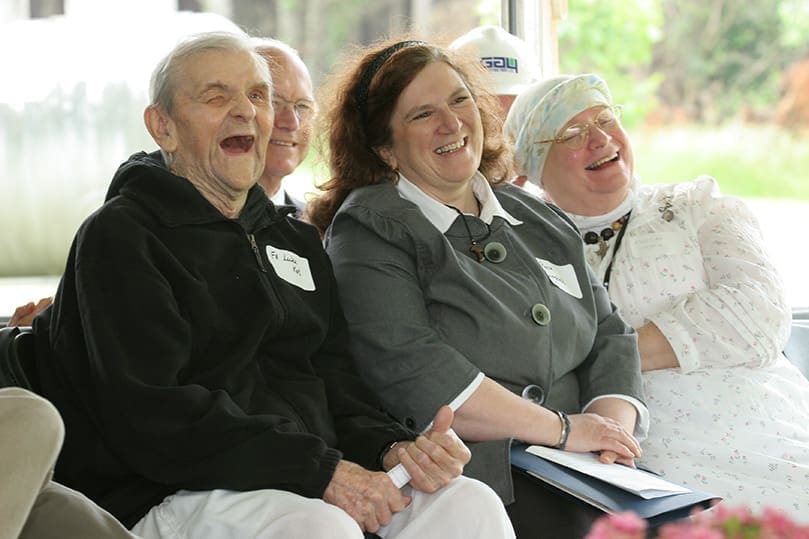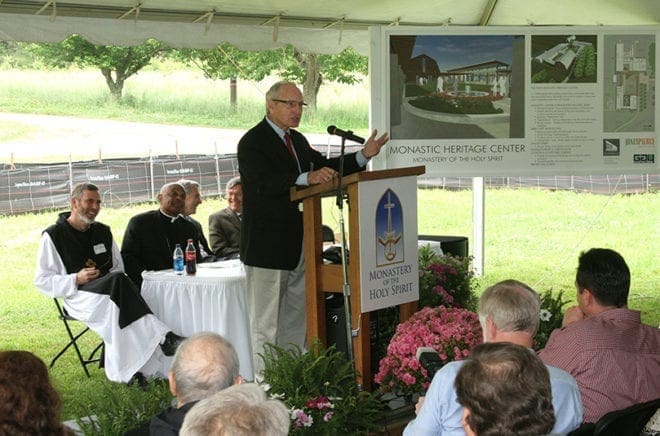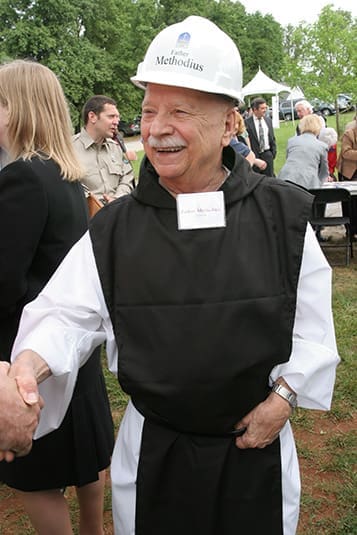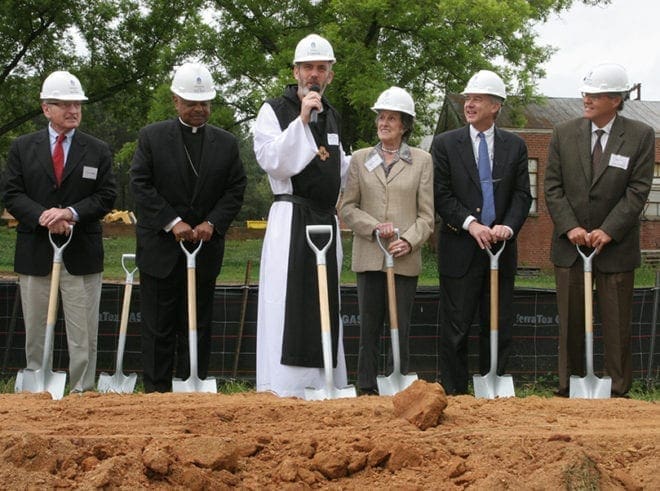 Photo By Michael Alexander
Photo By Michael AlexanderConyers
Trappists Break Ground For Monastic Heritage Center
By GRETCHEN KEISER, Staff Writer | Published May 27, 2010
As a bishop of Savannah did over 65 years ago, Bishop J. Kevin Boland of Savannah prayed this spring for God’s blessing on the new work beginning at the Trappist Monastery of the Holy Spirit, where ground was broken May 11 for the Monastic Heritage Center that will welcome visitors and sustain the community of cloistered monks in a new era.
Bishop Boland quoted his predecessor, Archbishop Gerald O’Hara of Savannah-Atlanta, who said in 1944 that the founding of the monastery in Georgia had “immense significance” for the diocese and the state, whose soil would receive “a new consecration by their prayers and sanctified labors.”
“They have established here a holy place, a house of prayer, a refuge for the world-weary, a sanctuary of hospitality,” Bishop Boland said.
“As we bend our backs to turn the earth” for the new construction, he prayed, “… provide this monastery with a setting of beauty and tranquility which speaks of prayer and peace and your presence and continually attracts those who are called by your Father to seek him daily in the intimacy of contemplation.”

Vince Dooley, co-chair of the Monastery Capital Campaign Leadership Committee, shares some monastery stories, as well as some stories from his days as head football coach at the University of Georgia, Athens. One particular story centered on a game in which the University of Notre Dame was the opponent. Photo By Michael Alexander
Speakers at the groundbreaking, gathered under a tent near where the monks first lived in a barn in 1944, represented the range and diversity of those involved in this project, which has been several years in the discernment, research, planning and fundraising stages.
They included Archbishop Wilton D. Gregory, Rockdale County and Conyers officials, supporters such as retired UGA athletic director Vince Dooley, and Kelly Jordan, the chairman of an adjoining natural and historic area project.
Father Methodius Telnack welcomes guests on hand for the Monastery of the Holy Spirit’s May 11 groundbreaking for its Public Gathering Space and Visitors Center, the Monastic Heritage Center.
Through a capital campaign, the monastery has raised approximately $3.7 million in donations and pledges and is now beginning the first phase of its master plan. This will include restoring and renovating the historic barn where the monks lived, building a cloister that will show the public the design and beauty of a monastic cloister, surrounding it with a new abbey gift shop and café, a center of monastic history worldwide and exhibits on monastic life, and an expanded area for the monastery’s industry of bonsai plants and pottery, as well as a greenhouse and garden.
There will also be a prayer walk that will guide visitors from this public area to the abbey church, while also maintaining the privacy and solitude of the cloistered areas where the monks live.
Building is scheduled to be completed by February 2011 and to cost an estimated $6.5 million. Fundraising is ongoing. The intent is to secure the financial stability of the monastery by making two of its strongest industries, tourism and its retreat center, even more viable and welcoming. At the same time the design is intended to preserve the tranquility and solitude of the monastic cloister.
Abbot Francis Michael Stiteler said, “This day has been seemingly long in coming and many, many people helped make it happen.”

Father Methodius Telnack welcomes guests on hand for the Monastery of the Holy Spirit’s May 11 groundbreaking for its Public Gathering Space and Visitors Center, the Monastic Heritage Center. Photo By Michael Alexander
He said benefactor Olga Goizueta, who provided funding at the beginning of the planning process, “gave us the courage to go forward” and businessman Michael Jansen, who began coming to the monastery as a youngster and helping on their farm, has been a major supporter in the capital campaign.
The abbot emphasized that the need for these changes is to return to what the Rule of St. Benedict asks of monks: to support themselves through their own work. Monasteries do not receive funding from the diocese where they are located. Over the decades the Conyers community has supported itself through a variety of industries, including farming, haying, sales of vegetables and plants, bread baking, homemade fudge and fruitcake industries, stained glass and bonsai.
In recent years the monks began to rely partially on donations as the cost of caring for their elderly monks rose precipitously and their industries did not keep pace. Their master plan reflects developing those industries that will allow them to be self-supporting again.
“It is a beginning, to get ourselves back again to the place where we were before: self-sufficient,” the abbot said.
Conyers Mayor Randy Mills said at the groundbreaking that the monastery already “is one of our community’s greatest resources … (and) is our county’s greatest tourist destination.”
The monastery has an estimated 70,000 visitors a year already and anticipates that number increasing significantly with the building of the Monastic Heritage Center and the linking of the monastery as the spiritual gateway to the nearby Arabia Mountain National Heritage Area.
Archbishop Gregory likened the spiritual identity of the monastery to its unique industry of bonsai, which is “a miniaturization of a real plant, a real tree, a small replica of large plants.”
“In a sense that is what a monastery is. It is a bonsai of God’s kingdom,” Archbishop Gregory said.
“It enriches us and it gives us a glimpse of how God would want us to live—with and for one another.”
He encouraged people to continue to assist the monastic community to reach its funding goal.
“In a very tough economic time we were able to raise at least half of what is needed,” Abbot Francis Michael said. “We do the rest in faith because we have to go forward.”
He said they are utilizing a $3.5 million line of credit, but hope that some or all of it will not be needed as fundraising continues.
The monastery, which opened when the Catholic population in Georgia was less than one-half of 1 percent, has always had strong ecumenical relations with other Christian denominations and interfaith visitors as well. It also created deep civic friendships with the community where it once operated a volunteer fire department and by its careful stewardship of its over 2,000-acre property.
Jordan, the volunteer director of the Arabia Mountain National Heritage Area, has known the monks since he was an Emory University student 40 years ago and he first came to view the abbey church they constructed.
The monastery’s creation of a wetland restoration bank and stream reforestation bank and a conservation burial ground or “green” cemetery are very contemporary concepts, he said. At the monastery, these forward-looking projects exist side by side with ageless enduring values that need to be preserved, such as solitude, frugality, modesty and respect for others, Jordan said.

Abbot Francis Michael Stiteler, OCSO, left center, addresses the crowd before he joins (l-r) Vince Dooley, co-chair of the Monastery Capital Campaign Leadership Committee, Archbishop Wilton D. Gregory, benefactor Olga C. de Goizueta, Conyers Mayor Randy Mills and Kelly Jordan, chair of the Arabia Mountain Heritage Area Alliance, for the ceremonial groundbreaking. Photo By Michael Alexander
It is “a treasure and a wonder,” he said. He hopes “people are going to want to help it prosper and survive.”
Two of the monks at the groundbreaking, who entered the Trappist order decades apart, expressed their support for the project.
“I think this is a wonderful occasion,” said Father Malachy Corley, 97, who entered the Conyers monastery in 1949. “At first I wasn’t too enthusiastic about the size of the project, but the Lord is evidently giving his blessings to our efforts and I think I may have been helpful in coming to the conclusion that tourism is going to pay off and help us to become as we should be—self-sufficient.”
Brother Guerric Riopel, who made his solemn profession of vows in 2006, said, “ All of us are very excited and enthusiastic about the whole project.”
“There has been a wonderful spirit,” Brother Guerric said. “Everyone really joined together for this.”
For more information on the Monastery of the Holy Spirit, visit www.trappist.net or call (770) 483-8705. The monastery is located at 2625 Highway 212, S.W., Conyers.